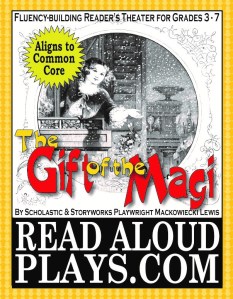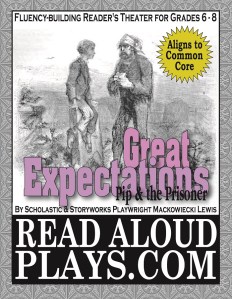My read-aloud plays have become mainstays in Scholastic classroom magazines. My first, an adaption of Charles Dickens’ A Christmas Carol, appeared in the December 1998 issue of Storyworks. Today I have dozens of plays in print. Some are available only to Scope and Storyworks subscribers, others are available in either of two collections, and many are available through TeachersPayTeachers. For three or four bucks, purchasers get reproduction and performance rights, and a nice set of standards-based comprehension activities.
Gabriel Grub
 Long before Scrooge there was Gabriel Grub, the gravedigger. From Dickens’ The Pickwick Papers, this eerie adaption is a perfect complement to the Christmas Carol story or a wonderful stand-alone Gothic holiday play. Gabriel is the sullen sexton who scowls at holiday mirth. He goes to the churchyard on Christmas eve to dig a grave and there encounters the Goblin King and a chorus of imps. He’s pulled into the grave and finds himself on trial for failing to believe in the Christmas Spirit. It’s Dickens’ at his best! Enough parts for an entire class, or double up roles and stage it with as few as twelve. Suitable for reader’s theater or a full stage production. Use it with grades 5 and up. (Warning: it may be too scary for younger students–be sure to listen to our radio drama podcast). Fully reproducible: original purchaser is licensed to print a class set each year for use in his or her own classroom.
Long before Scrooge there was Gabriel Grub, the gravedigger. From Dickens’ The Pickwick Papers, this eerie adaption is a perfect complement to the Christmas Carol story or a wonderful stand-alone Gothic holiday play. Gabriel is the sullen sexton who scowls at holiday mirth. He goes to the churchyard on Christmas eve to dig a grave and there encounters the Goblin King and a chorus of imps. He’s pulled into the grave and finds himself on trial for failing to believe in the Christmas Spirit. It’s Dickens’ at his best! Enough parts for an entire class, or double up roles and stage it with as few as twelve. Suitable for reader’s theater or a full stage production. Use it with grades 5 and up. (Warning: it may be too scary for younger students–be sure to listen to our radio drama podcast). Fully reproducible: original purchaser is licensed to print a class set each year for use in his or her own classroom.
The Shoemaker & the Christmas Elves
 The Brothers Grimm are known for dark, often violent tales, but the story of the Elves and the Cobbler is one of the only fairy tales with a Christmas theme—and a happy one at that. It tells the story of a kind-hearted shoemaker who receives some unexpected help just when he needs it most. Down to his last bit of leather with which to make shoes, his livelihood is saved by mysterious visitors—elves— who show up each night to finish the shoemaker’s work. To repay the elves for this Christmas miracle, the shoemaker and his wife decide to give a gift in return. In this version, it’s hinted that the shoemaker may, in fact, become Santa Claus, and that this is the beginning of his career as the ultimate gift giver. Included here is the original text, our play adaption, and a comprehension activity. There are enough parts for 12 students, including some fun, gibberish-speaking elves–and numerous non-speaking extras.
The Brothers Grimm are known for dark, often violent tales, but the story of the Elves and the Cobbler is one of the only fairy tales with a Christmas theme—and a happy one at that. It tells the story of a kind-hearted shoemaker who receives some unexpected help just when he needs it most. Down to his last bit of leather with which to make shoes, his livelihood is saved by mysterious visitors—elves— who show up each night to finish the shoemaker’s work. To repay the elves for this Christmas miracle, the shoemaker and his wife decide to give a gift in return. In this version, it’s hinted that the shoemaker may, in fact, become Santa Claus, and that this is the beginning of his career as the ultimate gift giver. Included here is the original text, our play adaption, and a comprehension activity. There are enough parts for 12 students, including some fun, gibberish-speaking elves–and numerous non-speaking extras.
The Gift of the Magi
 This is a traditional re-telling of the endearing story of a husband and wife who pawn their most precious things in order to buy gifts for one another, only to discover the gifts are no longer needed. The original story was written by William Sydney Porter, who wrote under the pen-name “O. Henry.” He was famous for plot twists and surprise endings. Students will likely be familiar with the plot because it’s been so readily adapted everywhere from Sesame Street to the Simpson’s to Walt Disney. Parts for nine students in grades 4 through 8. The Gift of the Magi originally appeared in the Nov.Dec. 2001 issue of Storyworks, was reprinted in the Dec. 2010 issue of Scope.
This is a traditional re-telling of the endearing story of a husband and wife who pawn their most precious things in order to buy gifts for one another, only to discover the gifts are no longer needed. The original story was written by William Sydney Porter, who wrote under the pen-name “O. Henry.” He was famous for plot twists and surprise endings. Students will likely be familiar with the plot because it’s been so readily adapted everywhere from Sesame Street to the Simpson’s to Walt Disney. Parts for nine students in grades 4 through 8. The Gift of the Magi originally appeared in the Nov.Dec. 2001 issue of Storyworks, was reprinted in the Dec. 2010 issue of Scope.
A Christmas Carol
 The Dickens classic comes alive with this age-appropriate version from the Dec. 1998 issue of Storyworks. It includes roles for fourteen students (though some can be doubled-up) as well as two or more non-speaking extras. In addition to being a pleasant holiday-oriented play, this is a great story for studying characterization and motivation. It includes two kid-friendly versions, the second having a female leads (Eleanora Scrooge rather than Ebenezer, Gladys Marley, and Tiny Tina). To see how far you can take a class play, be sure to check out the sixteen minute film my fifth graders created in 2012! (Note: Scrooge is available only during the holiday season. Bah Humbug!)
The Dickens classic comes alive with this age-appropriate version from the Dec. 1998 issue of Storyworks. It includes roles for fourteen students (though some can be doubled-up) as well as two or more non-speaking extras. In addition to being a pleasant holiday-oriented play, this is a great story for studying characterization and motivation. It includes two kid-friendly versions, the second having a female leads (Eleanora Scrooge rather than Ebenezer, Gladys Marley, and Tiny Tina). To see how far you can take a class play, be sure to check out the sixteen minute film my fifth graders created in 2012! (Note: Scrooge is available only during the holiday season. Bah Humbug!)
Pip & the Prisoner (from Great Expectations)
 “Pip & The Prisoner” is an original script based on the first five chapters of the Dickens’ masterpiece. The script endeavors to introduce the main character, Pip, in such a way as to motivate students to want to read the full novel (presumably when assigned to them in high school), but whether Great Expectations is in one’s curriculum or not, I think you’ll find “Pip & the Prisoner” to be a lovely stand-alone bit of literature. It’s aimed at 6th through 8th graders, but could potentially be used with students in other grades (I intend to use it with my 5th graders). Though not indicated so in the play itself, the story takes place on Christmas Eve, meaning it can be paired well with other Dickens holiday fare.
“Pip & The Prisoner” is an original script based on the first five chapters of the Dickens’ masterpiece. The script endeavors to introduce the main character, Pip, in such a way as to motivate students to want to read the full novel (presumably when assigned to them in high school), but whether Great Expectations is in one’s curriculum or not, I think you’ll find “Pip & the Prisoner” to be a lovely stand-alone bit of literature. It’s aimed at 6th through 8th graders, but could potentially be used with students in other grades (I intend to use it with my 5th graders). Though not indicated so in the play itself, the story takes place on Christmas Eve, meaning it can be paired well with other Dickens holiday fare.
The story is full of irony, anxiety, and engaging dialect as Dickens successfully captures Pip’s innocence and fears while weaving in marvelously subtle humor. The play seeks to capitalize on that humor. The 20-minute play includes parts for ten students and numerous non-speaking “soldiers.” It was written with the stage in mind, but it can also be presented as reader’s theater or a pod-casted radio drama. The script comes with embedded discussion prompts, a standards-based comprehension and essay writing activity, teacher’s notes, answer key, and a printable of the novel’s first five chapters for easy comparing and contrasting.
Escape from the Blacking House
 Escape from the Blacking House depicts the childhood of Charles Dickens. Based on thorough research, it reveals how the perilous trials of his youth—the poor house, child labor, and abandonment—inspired many of the novels for which he became famous. In fact, the play borrows from Dickens’ actual works such as The Pickwick Papers, Sketches by Boz, and Oliver Twist to create such scenes as “the pawnshop” and “the blacking house.” The play includes parts for 9 to 13 actors and numerous non-speaking extras . It is suitable for reader’s theater, podcast, radio drama, or full stage production. Because of the heavy reliance on dialect and language, hallmarks of a Dickens’ text, this is a challenging play. A strong fourth grade group might be able to handle it, but it’s aimed at 5th through 8th. Pair it with any of the other Dickens plays on my site.
Escape from the Blacking House depicts the childhood of Charles Dickens. Based on thorough research, it reveals how the perilous trials of his youth—the poor house, child labor, and abandonment—inspired many of the novels for which he became famous. In fact, the play borrows from Dickens’ actual works such as The Pickwick Papers, Sketches by Boz, and Oliver Twist to create such scenes as “the pawnshop” and “the blacking house.” The play includes parts for 9 to 13 actors and numerous non-speaking extras . It is suitable for reader’s theater, podcast, radio drama, or full stage production. Because of the heavy reliance on dialect and language, hallmarks of a Dickens’ text, this is a challenging play. A strong fourth grade group might be able to handle it, but it’s aimed at 5th through 8th. Pair it with any of the other Dickens plays on my site.
